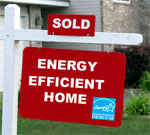I know that the home mortgage industry has taken a beating recently. But this actually sems like good news to me.
Lenders are [offering] homebuyers bigger loans or discounts if they are making energy-efficient improvements—or if their new home meets certain efficiency standards….
[E]nergy-efficient improvements could save a homeowner $50 a month. The $600 extra a year could allow a person to borrow about $10,000 more on a 30-year mortgage.
OK, I suppose that some people will say that this is just a way for mortgage brokers to sucker home buyers into going even deeper in debt. Just buy a better furnace,
But I think that’s too cynical. Energy efficient homes really are cheaper to operate, which gives homebuyers a little extra cash to buy a home that they’d really like to own.
And even though rolling energy efficiency into a mortgage payment may seem like a subtle change, I think it has the potential to be a reallybig deal, since it helps overcome what may be one of the biggest obstacles to efficiency investments: shortsightedness.
Typically, consumers are incredibly impatient when it comes to energy efficiency. Most of us wont make an efficiency investment, like a new furnace or fridge, unless it pays for itself within 3 years. In other words, we demand a 30% annual rate of return on efficiency investments—a rate that not even Warren Buffett could match. (Don’t think I’m scolding here—I’m as guilty of skimping on efficiency as anyone.)
Home buyers are no exception to this rule. They’ll pay extra for a nice kitchen, but tend to ignore efficiency features that save them money. A furnace upgrade, for example, doesn’t even break the top 22 projects on this list of projects that raise a home’s value. Worse, this site suggests that home buyers typically pay only 55 cents on the dollar for a new furnace. So if a homeowner spends $3,500 on an efficient new furnace, a home buyer will pay less than $2,000 for the courtesy—which makes the efficiency upgrade seem like a terrible bargain.
But banks are way more patient than home buyers. Sure, some bankers can get lured by the promise of easy cash (see, e.g., the recent high-risk mortgage meltdown). But for the most part, disciplined lenders think over the long term. And right now, they treat a 6% annual return as a decent investment—that’s the 30-year mortgage rate as of last Friday. In other words, bankers would settle for a return that’s one-fifth as high as what consumers demand.
So it should come as little surprise that banks should be willing to finance efficiency investments that consumers wouldn’t pay for on their own. The stream of energy savings that consumers overlook is a source of untapped revenue for a lender. To a banker, $50 per month over the long term really is worth $10,000 up front.
And that’s where the incentives for conservation really ramp up. You see, If there’s a competitive bidding situation, a bidder with a green mortgage can afford an extra $10K in sales price for every $50 in monthly energy savings. And that gives every homeowner contemplating putting a house on the market a huge incentive to upgrade that furnace. If the home bidding is competitive, a relatively inexpensive efficiency upgrade can net thousands of dollars in quick profits for a seller. No utility rebate program can match that.
Regardless of how much we preach, consumers are likely to remain impatient beasts, while lenders (the prudent ones, anyway) will look for slow, sure bets. A green mortgage can marry those two temperments: the consumer gets the cash up-front, and the banker gets the slow, steady, payout.
And the climate gets a little less CO2 in the bargain.








